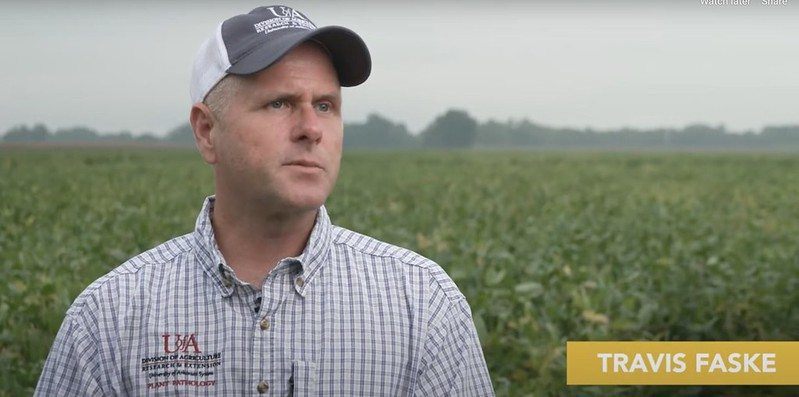Nov. 12, 2020
Faske videos guide viewers through nematode issues for soybean growers
By Mary Hightower
U of A System Division of Agriculture
Fast facts:
- Arkansas nematode videos available https://bit.ly/ArkTodesFaske
- Root knot nematode a threat to Arkansas soybeans
(484 words)
(Newsrooms – ‘SCNCoalition’ as one word is CQ)
(Download this story in MS Word format here.)
LONOKE, Ark. — Tiny southern root-knot nematodes can make a big dent in yields and managing these miniature roundworms is a top priority for soybean growers.
Nematodes are a large and diverse roundworm family whose members include a host of parasites of humans, livestock and plants, including Guinea worms and barber pole worms. They are blamed for billions of dollars in losses every year.
Travis Faske, extension plant pathologist for the University of Arkansas System Division of Agriculture, has worked with the SCNCoalition to produce a series of videos called “Let’s Talk ‘Todes,” geared specifically for Arkansas growers.
“There are 100 species of root-knot nematodes and five that can affect soybean production,” Faske said. “One of those five is the southern root-knot nematode, which is the No. 1 nematode problem in the state and has increased in distribution over the past 40 years.”
The southern root-knot nematode is found in 85 percent of Arkansas’ soybean producing counties.
“My program is one of the very few that is conducting applied research to mitigate yield losses by this nematode,” Faske said. “I often get calls from around the country about managing this species on soybean. Just last week I got a call from a soybean farmer in Indiana and one in Oklahoma.”
Faske said he’s been involved with the coalition for a year or two and the videos provided the first opportunity to be a voice over a national platform about nematode issues facing farmers in the South.
As its name implies, the root-knot nematode can feed on a plant’s root system, damaging the plant’s ability to absorb water and nutrients. Damage left by the nematodes can also provide openings for fungal and bacterial infections.
Faske offers management advice in the videos, available at https://bit.ly/ArkTodesFaske.
A key step to managing nematodes is sampling. Samples can be submitted to the Division of Agriculture’s Nematode Diagnostic Laboratory in Hope. (See: https://aaes.uark.edu/technical-services/nematode-diagnostic-laboratory/.)
“We are one of the few states that have a nematode diagnostic lab and one of the leading states that has continued to provide farmers support by offering this service free of charge,” Faske said. “Because production systems change every few years, we in extension recommend sampling every three to four years to monitor changes in nematode population densities.”
“For the past five years the Arkansas Soybean Promotion Board has supported free nematode assays,” Faske said. He said that also weather conditions had not been favorable for sampling efforts during the past two years, growers and consultants have been taking advantage of better conditions in 2020.
Two Division of Agriculture publications offer additional information on nematode management:
- The fact sheet “Management of Economically Important Nematodes of Arkansas Cotton,” https://www.uaex.uada.edu/publications/PDF/FSA-7567.pdf
- The “Arkansas Soybean Production Handbook,” https://www.uaex.uada.edu/publications/pdf/mp197/chapter10.pdf
The SCNCoalition is a group of extension specialists, university researchers and private sector representatives working to address nematode management. The SCNCoalition is funded by the soybean checkoff, including the Arkansas Soybean Promotion Board.
To learn more about extension and research programs in Arkansas, visit https://uada.edu/.
Follow us on Twitter at @AgInArk, @uaex_edu or @ArkAgResearch.
About the Division of Agriculture
The University of Arkansas System Division of Agriculture’s mission is to strengthen agriculture, communities, and families by connecting trusted research to the adoption of best practices. Through the Agricultural Experiment Station and the Cooperative Extension Service, the Division of Agriculture conducts research and extension work within the nation’s historic land grant education system.
The Division of Agriculture is one of 20 entities within the University of Arkansas System. It has offices in all 75 counties in Arkansas and faculty on five system campuses.
Pursuant to 7 CFR § 15.3, the University of Arkansas System Division of Agriculture offers all its Extension and Research programs and services (including employment) without regard to race, color, sex, national origin, religion, age, disability, marital or veteran status, genetic information, sexual preference, pregnancy or any other legally protected status, and is an equal opportunity institution.
# # #
Media Contact: Mary Hightower
Chief Communications Officer
University of Arkansas System Division of Agriculture
mhightower@uada.edu
501-671-2006
